Alkyl halides - Study guides, Class notes & Summaries
Looking for the best study guides, study notes and summaries about Alkyl halides? On this page you'll find 146 study documents about Alkyl halides.
Page 4 out of 146 results
Sort by

-
CHM 219 MODULE 4 EXAM | QUESTIONS & ANSWERS (VERIFIED) | LATEST UPDATE | GRADED A+
- Exam (elaborations) • 8 pages • 2024
-
- $10.99
- + learn more
1 CHM 219 MODULE 4 EXAM | QUESTIONS & ANSWERS (VERIFIED) | LATEST UPDATE | GRADED A+ Organohalides Correct Answer: Organic molecules contains Halogen atoms. Ex. Algae, Mollusk, sponges, can be industrially used - solvents, insecticides, herbicides, cleaning fluids, fire retardants, refrigerants. Can also be used as inhaled anesthetic. More important in organic chemistry because of theur reactivity. Two of the most important reaction types typical of organic Halides are.... Corr...
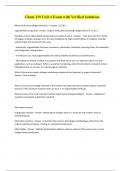
-
Chem 219 Unit 4 Exam with Verified Solutions
- Exam (elaborations) • 15 pages • 2024
-
- $10.09
- + learn more
Chem 219 Unit 4 Exam with Verified Solutions What are the four halogen elements? - Answer -F, Cl, Br, I organohalide compounds - Answer -Organic molecules containing halogen atoms (F, Cl, Br, I) Examples of how organohalide compounds are used by humans - Answer -- have been found in marine life (algae, mollusks, sponges, etc.), bc they metabolize the high concentrations of inorganic chlorides and bromides that are found in the seas. - Industrially, organohalides find uses as solvents, inse...
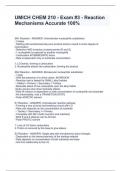
-
UMICH CHEM 210 - Exam #3 - Reaction Mechanisms Accurate 100%
- Exam (elaborations) • 3 pages • 2024
- Available in package deal
-
- $10.49
- + learn more
SN1 Reaction - ANSWER- Unimolecular nucleophilic substitution - 2 steps - Starting with enantiomerically pure product tends to result in some degree of racemization - Retention AND inversion at stereocenter (R and S) - 1 nucleophile is replaced by another nucleophile - Carbocation INTERMEDIATE forms - Rate is dependent only on substrate concentration 1. LG leaves, forming a carbocation 2. Nucleophile attacks the carbocation, forming the product SN2 Reaction - ANSWER- Bimolecular nuc...

-
CHM 219 Module 4 test with complete solution
- Exam (elaborations) • 4 pages • 2024
-
- $7.99
- + learn more
Organohalides - ANSWER-Organic molecules contain Halogen atoms. Ex. Algae, Mollusk, sponges, can be industrially used - solvents, insecticides, herbicides, cleaning fluids, fire retardants, refrigerants. Can also be used as inhaled anesthetic. More important in organic chemistry because of theur reactivity. Two of the most important reaction types typical of organic Halides are.... - ANSWER-Substitution Elimination Substitution Reaction - ANSWER-Replacing the halogen in a molecule with a...
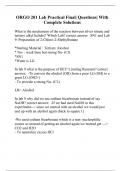
-
ORGO 201 Lab Practical Final| Questions| With Complete Solutions
- Exam (elaborations) • 17 pages • 2023
-
- $12.99
- + learn more
What is the mechanism of the reaction between silver nitrate and tertiary alkyl halides? Which Lab? correct answer: SN1 and Lab 9: Preparation of 2-Chloro-2-Methylbutane *Starting Material : Tertiary Alcohol * Nu- : weak base but strong Nu- (Cl) *SN1 *Water is LG In lab 9 what is the purpose of HCl? Limiting Reactant? correct answer: -To convert the alochol (OH) from a poor LG (OH) to a great LG (OH2+) - To provide a strong Nu- (Cl-) LR= Alcohol In lab 9 why did we use sodium ...
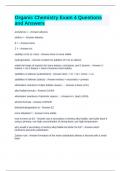
-
Organic Chemistry Exam 4 Questions and Answers
- Exam (elaborations) • 5 pages • 2024
- Available in package deal
-
- $10.49
- + learn more
acetylenes = - Answer-alkynes olefins = - Answer-alkenes E = - Answer-trans Z = - Answer-cis stability of cis vs. trans - Answer-trans is more stable hydrogenation - Answer-exothermic addition of H to an alkene relate the heats of reaction for trans-butene, cis-butene, and 1-butene. - Answer-1-butene > cis-2-butene > trans-2-butene (most stable) stabilities of alkenes (substitution) - Answer-tetra- > tri- > di-> mono- > un- stabilities of alkenes (status...
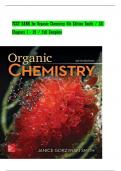
-
TEST BANK for Organic Chemistry 6th Edition By Janice Smith (Complete 29 Chapters)
- Exam (elaborations) • 348 pages • 2024
-
- $16.49
- + learn more
TEST BANK for Organic Chemistry 6th Edition By Janice Smith (Complete 29 Chapters). Chapter 1 Structure and Bonding Chapter 2 Acids and Bases Chapter 3 Introduction to Organic Molecules and Functional Groups Chapter 4 Alkanes Chapter 5 Stereochemistry Chapter 6 Understanding Organic Reactions Chapter 7 Alkyl Halides and Nucleophilic Substitution Chapter 8 Alkyl Halides and Elimination Reactions Chapter 9 Alcohols, Ethers, and Related Compounds Chapter 10 Alkenes and Addition Reactions Chapter 11...
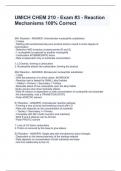
-
UMICH CHEM 210 - Exam #3 - Reaction Mechanisms 100% Correct
- Exam (elaborations) • 3 pages • 2024
- Available in package deal
-
- $9.99
- + learn more
UMICH CHEM 210 - Exam #3 - Reaction Mechanisms 100% Correct SN1 Reaction - ANSWER- Unimolecular nucleophilic substitution - 2 steps - Starting with enantiomerically pure product tends to result in some degree of racemization - Retention AND inversion at stereocenter (R and S) - 1 nucleophile is replaced by another nucleophile - Carbocation INTERMEDIATE forms - Rate is dependent only on substrate concentration 1. LG leaves, forming a carbocation 2. Nucleophile attacks the carbocati...
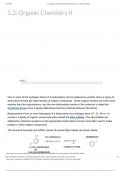
-
5.2: Organic Chemistry II
- Summary • 4 pages • 2024
-
- $17.99
- + learn more
5.2: Organic Chemistry II One or more of the hydrogen atoms of a hydrocarbon can be replaced by another atom or group of atoms thus forming the other families of organic compounds. These organic families are much more reactive than the hydrocarbons, and the non-hydrocarbon portion of the molecule is called the functional group since it largely determines how the molecule behaves (functions). Replacement of one or more hydrogens of a hydrocarbon by a halogen atom (-F, -Cl, -Br or –I) resu...
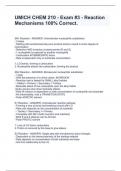
-
UMICH CHEM 210 - Exam #3 - Reaction Mechanisms 100% Correct.
- Exam (elaborations) • 3 pages • 2024
- Available in package deal
-
- $13.49
- + learn more
SN1 Reaction - ANSWER- Unimolecular nucleophilic substitution - 2 steps - Starting with enantiomerically pure product tends to result in some degree of racemization - Retention AND inversion at stereocenter (R and S) - 1 nucleophile is replaced by another nucleophile - Carbocation INTERMEDIATE forms - Rate is dependent only on substrate concentration 1. LG leaves, forming a carbocation 2. Nucleophile attacks the carbocation, forming the product SN2 Reaction - ANSWER- Bimolecular nuc...

How did he do that? By selling his study resources on Stuvia. Try it yourself! Discover all about earning on Stuvia


